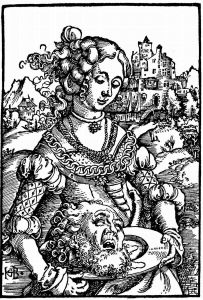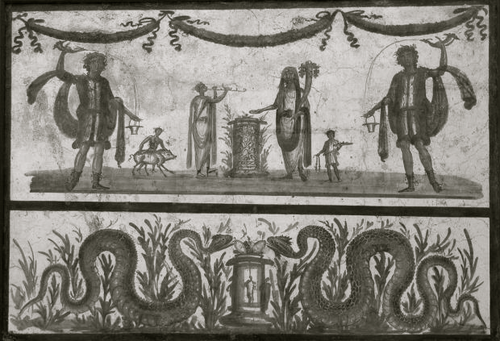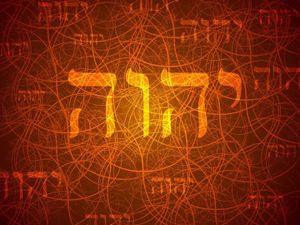Unless otherwise noted, all scripture quotations are from the New King James Version
Birthday celebrations are a big part of our Western culture: birthday cakes and gifts are part of this tradition. But what has God to say about it? Is it only innocent fun? Does it really matter what we do as followers of Christ in such occasions, in other words can we choose to celebrate it or not as part of our so-called “Christian liberty”? In this essay we will endeavor to answer those questions by looking at the Word of God, but also what early Church history and what first century Judaism (Jesus/Yeshua was a first century Jew) has to say about this topic. Finally, we will take a brief look at ancient customs associated with birthday celebrations.
Birthdays in the Bible
Birthday celebrations are not often mentioned in the Scriptures; in fact throughout the whole Protestant canon of the Bible there is only two direct mentions made of birthday celebrations. We will also see another couple of places, where some scholars believe mentions are made of birthday celebrations.

Salome with the head of John the Baptist by Hans Baldung Grien
The first account in the Protestant canon of Bible is found in Genesis 40:1-23. In verse 20, we read: “Now it came to pass on the third day, which was Pharaoh’s birthday, that he made a feast for all his servants; and he lifted up the head of the chief butler and of the chief baker among his servants.” The second account is found in the Gospels. In Matthew 14:6, we read: “But when Herod's [Antipas, who reigned from 6 AD to 39 AD] birthday was kept, the daughter of Herodias danced before them, and pleased Herod”. And in Mark 6:21 the following is said: “And when a convenient day was come, that Herod on his birthday made a supper to his lords, high captains, and chief estates of Galilee.” During this birthday feast, John the Baptist was tragically beheaded.
In those passages of the Scriptures, we see two powerful men celebrating their birthday with great pomp. This is consistent with what we know of Ancient Middle Eastern history and customs. The International Standard Bible Encyclopedia states: “The custom of observing birthdays of great men, especially of kings, was widespread in ancient times.” The Smith's Bible Dictionary agrees: “The custom of observing birthdays is very ancient; Genesis 40:20; Jeremiah 20:15 and in Job 1:4 etc., we read that Job's sons "feasted every one his day." In Persia birthdays were celebrated with peculiar honors and banquets, and in Egypt those of the king were kept with great pomp.”
The book of 2 Maccabees gives us another account of birthday celebration. Although not found in the Protestant canon of the Bible, the book of 2 Maccabees was originally used by Alexandrian Jews as part of their canon of Scriptures called the Septuagint. The authors of the New Testament were quoting from the Septuagint in their writings. The book of 2 Maccabees is still considered canonical by the Catholics, the Eastern Orthodox tradition, the Assyrian Eastern tradition and most of the Western Orthodox tradition. It is considered non-canonical by Protestants and modern Jews. Still, both Protestants and modern Jews consider this book from interest on an historical level. This is how we will use this book in this essay. Concerning birthday celebrations, we read an interesting account in 2 Maccabees 6:1-9.
“Not long after this, the king sent an Athenian senator to compel the Jews to forsake the laws of their ancestors and no longer to live by the laws of God; also to pollute the temple in Jerusalem and to call it the temple of Olympian Zeus, and to call the one in Gerizim the temple of Zeus-the-Friend-of-Strangers, as did the people who lived in that place. Harsh and utterly grievous was the onslaught of evil. For the temple was filled with debauchery and reveling by the Gentiles, who dallied with prostitutes and had intercourse with women within the sacred precincts, and besides brought in things for sacrifice that were unfit. The altar was covered with abominable offerings that were forbidden by the laws. People could neither keep the sabbath, nor observe the festivals of their ancestors, nor so much as confess themselves to be Jews. On the monthly celebration of the king’s BIRTHDAY, the Jews were taken, under bitter constraint, to partake of the sacrifices; and when a festival of Dionysus was celebrated, they were compelled to wear wreaths of ivy and to walk in the procession in honor of Dionysus. At the suggestion of the people of Ptolemais a decree was issued to the neighboring Greek cities that they should adopt the same policy toward the Jews and make them partake of the sacrifices, and should kill those who did not choose to change over to Greek customs”
- New Revised Standard Version
In this passage of 2 Maccabees, we learn of a pagan king, Antiochus IV Epiphanes, who desecrates the Temple by false worship, sexual immorality and unclean sacrifices. He also forbid Jews to keep God’s commandments and obliges them to partake in idol worship, including celebrating his birthday once a month.
As we have read earlier, birthday of great men were celebrated in ancient times. This was part of what we would call today cult of personality. In fact, many Greek and Roman leaders were worshipped as gods. Antiochus IV Epiphanes was one of those Greek leaders claiming to be a god. Concerning Egyptian Pharaohs, the Ancient History Encyclopedia states that they “were equated with the gods and with the duties and obligations due those gods. As supreme ruler of the people, the pharaoh was considered a god on earth, the intermediary between the gods and the people, and when he died, he was thought to become Osiris, the god of the dead.” Celebrating their birthday was a form of worship.
As for Herod Antipas in Matthew 14:6 and Mark 6:21, it is certainly with the same spirit and because of the same cult of personality that he was celebrating his birthday. In fact, one of his nephews Herod Agrippa on one instance at least is depicted as being worshipped as a god. “So on a set day Herod [Agrippa, who reigned from 41 to 44 AD], arrayed in royal apparel, sat on his throne and gave an oration to them. And the people kept shouting, “The voice of a god and not of a man!” Then immediately an angel of the Lord struck him, because he did not give glory to God. And he was eaten by worms and died” (Acts 12:21-23).
We find two more mentions of possible birthday celebrations in the Scriptures. One is found in Hosea 7:5, in which we read: “In the day of our king Princes have made him sick, inflamed with wine; He stretched out his hand with scoffers.” According to Gill's Exposition of the Entire Bible and Wesley's Notes, this passage can possibly refer to a birthday celebration or an annual coronation celebration. In any cases, this is associated with drunkenness and ungodly behaviors. The other instance is found in Job 1:4-5.
“And his sons would go and feast in their houses, each on his appointed day, and would send and invite their three sisters to eat and drink with them. So it was, when the days of feasting had run their course, that Job would send and sanctify them, and he would rise early in the morning and offer burnt offerings according to the number of them all. For Job said, “It may be that my sons have sinned and cursed God in their hearts.” Thus Job did regularly.”
A number of commentators believe that “each on his appointed day” is to be understood as mentioning birthday celebrations. This is the case for the Jamieson-Fausset-Brown Bible Commentary, the Clarke's Commentary on the Bible and also for the Smith's Bible Dictionary. The Pulpit Commentary reads:
“Verse 4. - And his sons went and feasted. "Went and feasted" seems to mean "were in the habit of feasting" (Rosenmuller, Lee). In their houses. Each had his own residence, and the residence was not a tent, but a" house." Job and his sons were not mere nomads, but belonged to the settled population. The same is implied by the "ploughing of the oxen" (ver. 14), and indeed by Job's "yoke of oxen" in ver. 3. Every one his day. Most commentators regard these feasts as birthday festivities. Each son in his turn, when his birthday arrived, entertained his six brothers. Others think that each of the seven brothers had his own special day of the week on which, he received his brothers at his table, so that the feasting was continuous. But this scarcely suits the context. And it is admitted that "his day" (in Job 3:1) means "his birthday." The celebration of birthdays by means of a feast was a very widespread custom in the East (see Genesis 40:20; Herod., 1:133; 9:110; Mark 14:21). And sent and called for their three sisters to eat and to drink with them. This by itself is sufficient to show that the feasts were occasional, not continuous. Constant absence of daughters, day after day, from the parental board is inconceivable.”
If these are birthday celebrations, as those commentators believe, we notice that Job wasn’t taking part into those feast days. He would rather “send and sanctify them, and he would rise early in the morning and offer burnt offerings according to the number of them all. For Job said, “It may be that my sons have sinned and cursed God in their hearts” (verse 5).
As we have seen so far in those passages, birthday celebrations and/or personal feast days are essentially the fact of self-deified rulers and if they are not, as in the case of Job’s children, they may potentially result in sin.
First century Judaism and early Christian history on birthdays
Now that we have studied the several instances in which the Scriptures mention birthday celebrations, let see if first century Judaism and early Christian history has anything to teach us about such celebrations. We ought to remember that Jesus (Yeshua in Hebrew) was a Jew, which makes it relevant for us to know what was first century Jewish view, and subsequently early Christian belief, in regard to such celebrations.
In fact, first century Judaism is not silent on the subject. Josephus (37 to 100 AD), a Jewish scholar and historian born in Jerusalem to a father of priestly descent wrote about birthday celebrations in his two-volume work in defense of Judaism titled Against Apion. In book II and chapter 26, we read:
“Nay, indeed, the law does not permit us to make festivals at the births of our children, and thereby afford occasion of drinking to excess; but it ordains that the very beginning of our education should be immediately directed to sobriety. It also commands us to bring those children up in learning, and to exercise them in the laws, and make them acquainted with the acts of their predecessors, in order to their imitation of them, and that they might be nourished up in the laws from their infancy, and might neither transgress them, nor have any pretense for their ignorance of them.”

A bust of the Jewish historian Flavius Josephus
The Jewish Encyclopedia somehow agrees when stating: “There are no positive data in the Bible or in rabbinical literature concerning birthday festivals among the ancient Jews. This silence on the subject is, however, no warrant for the conclusion that the Jews altogether abstained from following a custom which was general among the Egyptians (Gen. xl. 20), Persians (Herodotus i. 133), Syrians, and Greeks. Even if not common among the people, yet kings and princes probably practiced it, following the custom of their heathen contemporaries.” Here we learn that birthday celebrations were not common among the people and were in fact borrowed from the heathens when practiced by kings and princes. In the Encyclopaedia Judaica, we read: “The celebration of birthdays is unknown in traditional Jewish ritual. A comparatively late exception, however, is the *bar mitzvah and the bat mitzvah. The only reference to a birthday in the Bible is that celebrated by Pharaoh (Gen. 40:20). In Reform and Conservative synagogues, special prayers of thanksgiving are recited on the occasion of significant birthdays (e.g., 50th, 70th, 80th, etc.) and at silver and golden wedding anniversaries.” In modern times, the topic of birthday celebrations is somewhat of a controversy in Judaism. While many Jews celebrate birthdays, some like Rabbi Chaim Elazar Shapiro (1871-1937) find no mention of such celebrations in rabbinic literature and believe that such celebrations is antithetical to “the Jewish trait of humility.”
Since early Christianity was still closely connected to first century Judaism, we should not be surprised to find birthday celebrations mentioned in a negative way. Indeed, in The Westminster Handbook to Origen (2004) edited by John Anthony McGuckin, we read :
“[w]hen commenting on Herod’s birthday as mentioned in Matthew 14:6, Origen castigates those who revel in their birthdays and recalls a Philonic text [Philo being a Hellenistic Jewish] that he had once read (De ebriatate 208): “Indeed one of our predecessors has observed that the birthday of Pharaoh is recorded in Genesis and recounts that it is the wicked man who, being in love with the affairs of birth and becoming, celebrates his birthday. But we, taking our cue from that interpreter, discover that nowhere in the scriptures is a birthday celebrated by a righteous person.””
Origen was a scholar and early Christian theologian (185 to 232 AD) who wrote a number of commentaries on the Bible and had a great influence on early Christianity. Another early Christian apologist, Arnobius of Sicca (284 to 305 AD) wrote, visibly holding in contempt birthday celebrations and speaking of Roman leaders: “Who, with licentious violence, undermine and wrest away the chastity of matrons and maidens, - these men you name indigites and divi; and you worship with couches, altars, temples, and other service, and by celebrating their games and birthdays, those whom it was fitting that you should assail with keenest hatred” (Against the Heathen. Book I, Chapter 64).
While we might disagree with first century Judaism in regard to the Messiah, while we might not agree with all that was written by early Christian commentators and apologists, those quotations still give us a fair idea of what was the New Testament writers view on birthday celebrations.
Birthdays and paganism
The reasons for the first century Jews and early Christian believers to not celebrate birthdays are not to be found only in their understanding of the Scriptures, but are also to be understood in correlation with the pagan customs associated with birthday celebrations. According to Kathryn Argetsinger in her research titled Birthday Rituals: Friends and Patrons in Roman Poetry and Cult (Classical Antiquity, 1992), the “people of late republican Rome celebrated at least three types of dies natales. In the private sphere, Roman men and women marked their own birthdays and the birthdays of family members and friends with gift giving and banquets. In the public sphere, the natales of temples and the natales of cities were observed; these “birthdays” were actually the anniversaries of the days on which particular cults, or cities, had been founded.” Each of these types of birthdays was accompanied with religious rituals. According to the same authors, each private birthday was linked to a personal deity to whom an individual would make an offering in exchange for protection. Kathryn Argetsinger affirms in her research: “[W]hen relatives, friends, or clients celebrated a relative or patron’s birthday, they were bound, if they were truly pious, by the same sort of specific cult requirement as they were on their own birthdays.” Birthday greetings were religious acts accompanied by three type of offerings made to an idol or to the “genius” [the guardian spirit of a person] of an individual: incense, rituals cakes, and wine (Does that sound familiar?). Some ancient sources cited by the author seem to refer to the “genius” as being “some internal part of the self,” part of “a man as well as well as an external deity.” They were some “sort of ego extension into the divine sphere.” The Roman poet Horace, in one of his writings, Ode 4.11, reports going as far as sacrificing a lamb on one occasion for the birthday of his patron Maecenas. The author concludes: “In undertaking celebration of another’s birthday a Roman undertook in part a religious obligation expressed by annually renewed vota [wishes] and ritual,” and “through this act of piety a Roman gained a new network of divine as well as earthly friends and patrons.”

Mural from Pompeii. Domestic sacrifice with a genius familiaris and Lares (household gods).
Naples: National Museum. Lares are represented on the left and on the right, top level.
Such belief is not exclusive to Romans. In their book titled The Lore of Birthdays (1952), Ralph and Adelin Linton, gives a brief look at the history of birthday celebrations: “The Greeks believed that everyone had a protective spirit or daemon who attended his birth and watched over him in life. This spirit had a mystic relation with the god on whose birthday the individual was born.” Furthermore, in the same book we read:
“[T]he idea [of birthday greetings and wishes for happiness] was rooted in magic. The working of spells for good and evil is the chief usage of witchcraft. One is especially susceptible to such spells on his birthday, as one’s personal spirits are about at that time. Dreams dreamed on the birthday eve should be remembered, for they are predictions of the future brought by the guardian spirits which hover over one’s bed on the birthday eve. Birthday greetings have power for good or ill because one is closer to the spirit world on this day. Good wishes bring good fortune, but the reverse is also true, so one should avoid enemies on one’s birthday and be surrounded only by well-wishers. ‘Happy birthday’ and ‘Many happy returns of the day’ are the traditional greetings”
And:
“Birthdays are intimately linked with the stars, since without the calendar, no one could tell when to celebrate his birthday. They are also indebted to the stars in another way, for in early days the chief importance of birthday records was to enable the astrologers to chart horoscopes”
By reading those descriptions of pagan birthday celebrations, we better understand why the early believers would refrain from celebrating them. Such celebrations are highly connected with pagan worship and even the occult. Looking back at those ancient beliefs, this is no surprise that a very controversial individual, Anton Lavey (founder of the Church of Satan), writes in his book titled The Satanic Bible (1969): “After one’s own birthday, the two major Satanic holidays are Walpurgisnacht and Halloween (or All Hallows’ Eve).” Of course, Anton Lavey has a different take on birthdays. He merely sees birthdays as glorification of oneself: “Every man is a god if he chooses to recognize himself as one. So, the Satanist celebrates his own birthday as the most important holiday of the year.” For ancient civilizations, birthday celebrations were rather a way to connect with the gods and with the society at large. In any case, both self-glorification and worship of personal gods is condemned in the Bible.
On a side note, it should of interest for believers that the Scriptures do not mention the date of birth of the greatest man who ever lived, the Messiah Yeshua (Jesus Christ). It shows how unimportant it was for early Christians the date of someone birth in a world in which gods, kings and even common people were celebrating their birthdays in a religious manner. In fact, concerning December 25th, and according to M. J. Vermaseren; C. C. Van Essen in their essay titled The Excavations in the Mithraeum of the Church of Santa Prisca on the Aventine (Journal of Biblical Literature. 1966): "One should bear in mind that the Mithraic New Year began on Natalis Invicti, the birthday of their invincible god, i.e. December 25th, when the new light […] appears from the vault of heaven."
What should a believer do?
The Bible does not condemn acknowledging someone’s age. In fact, the Bible makes a connection between age and wisdom. In Proverbs 9:11, we read: “For by Wisdom your days will be many, and years will be added to your life” (Holman Christian Standard Bible). Life is a gift of our Heavenly Father, for which we should rejoice everyday of our life. “By You I have been upheld from birth; You are He who took me out of my mother’s womb. My praise shall be continually of You” (Psalm 71:6). In the meantime, the Bible does not encourage self-glorification. On the contrary the Bible teaches humility and self-denial. In Matthew 16:24, Jesus Christ said to the disciples: “If anyone desires to come after Me, let him deny himself, and take up his cross, and follow Me.” Paul agrees, who wrote: “Therefore, brethren, we are debtors—not to the flesh, to live according to the flesh. For if you live according to the flesh you will die; but if by the Spirit you put to death the deeds of the body, you will live. For as many as are led by the Spirit of God, these are sons of God” (Romans 8:12-14). By showing love towards God and towards our neighbors and by denying ourselves we become children of God. In our individualistic society, this is so important to feel recognized. Many people will feel offended because they were not wished a “happy birthday” or because they didn’t receive the expected gift on their birthday. Meanwhile, the Bible tells us “[i]t is more blessed to give than to receive” (Acts 20:35).
Another important aspect of birthday celebrations to consider is the pagan customs associated with those celebrations. The Bible warns us strongly against pagan customs and against mixing the proper worship of God with ungodly practices. This is true not only in the Tanakh, the Old Testament, but also in the apostolic writings. In 2 Corinthians 6:14-16, we read: “And what communion has light with darkness? And what accord has Christ with Belial? Or what part has a believer with an unbeliever? And what agreement has the temple of God with idols? For you are the temple of the living God.” Some customs and traditions may seems innocuous, but God gives us clear boundaries stones so that we may not fall back into sin after having become one of his children. We need to remember whom we worship and from whom we are receiving a true and genuine gift: “Every good gift and every perfect gift is from above, and comes down from the Father of lights, with whom there is no variation or shadow of turning” (James 1:17). We ought to have a discerning spirit and to be cautious in our deeds, including how and why we do celebrate birthdays. We need to remember who is our God so that we can remain holy. Therefore, let’s “[c]ome out from among them and be separate” and God “will be a Father to [us],” and we “shall be [His] sons and daughters” (2 Corinthians 6:17-18) says the Scriptures. Amen!














